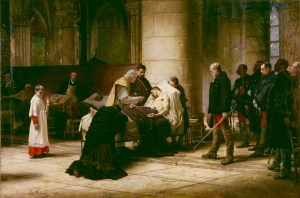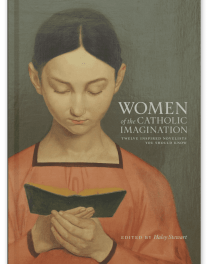We support our Publishers and Content Creators. You can view this story on their website by CLICKING HERE.
Most Catholics have never heard of Roy Campbell. He is forgotten. Neglected. Buried, so it seems, by the inexorable and merciless sands of time. Such neglect is nothing short of scandalous. There was a time, however, when he enjoyed fame and endured infamy, a time in which the very mention of his name would excite radically opposing reactions. He was attacked bitterly by C.S. Lewis and defended vociferously by J.R.R. Tolkien, the latter of whom compared him to the mysterious character of Strider in The Lord of the Rings.
So, who was this man who could excite such controversy? And why should he be considered one of the unsung heroes of Christendom?
Let’s delve and dive a little deeper into the facts of his life.
Roy Campbell was born in South Africa in 1901 and came to England in 1919. Settling in London, he became part of the city’s decadent bohemian underbelly, mixing with artists and artists’ models in a subculture of hedonistic drinking and partying. As a wild colonial boy, with a strange accent and strange ways, he was given the nickname “Zulu.” Then, in 1924, following the publication of The Flaming Terrapin, he was acclaimed as one of the most exciting new poets of his day. Those who admired his work included some of the most important poets of the time, including T.S. Eliot, Dylan Thomas, and Edith Sitwell.
Campbell’s discomfort with the culture of decadence in which he found himself was implicit in The Flaming Terrapin and would become explicit in his next major poem, The Georgiad, in which he satirized the writers and intellectuals of the Bloomsbury Group, such as Virginia Woolf, Bertrand Russell and Marie Stopes. In attacking the atheist philosophy of Bertrand Russell and the pioneer of the culture of contraception and eugenics, Marie Stopes, Campbell was distancing himself from the world of hedonism and sexual libertinism and seeking a healthier way of seeing things and doing things.
Campbell fled to Provence in the south of France, falling in love with the Catholic culture in which he found himself and feeling at home with the peasants and fishermen whom he befriended. He lived in this part of France with his wife, Mary, and their two young daughters until 1933, at which point they moved to Spain. Living for a short time in Barcelona, the family then moved to the village of Altea on the Costa Blanca. It was here, in 1935, that Campbell and his family were received into the Catholic Church. Shortly afterward, they moved to Toledo, Spain’s ancient capital city, just as the country was sliding toward its cataclysmic civil war.
In March 1936, the churches of Toledo were burned in a series of violent riots in which priests and nuns were attacked. During these bloody disturbances, Roy and Mary Campbell sheltered in their house several of the Carmelite monks from the neighboring monastery. In the following weeks, the situation worsened. Portraits of Marx and Lenin were posted on every street corner, and horrific tales began to filter in from surrounding villages of priests being shot and wealthy men being butchered in front of their families.
Toledo’s beleaguered Christians braced themselves for the next wave of persecution, and the Campbells, in an atmosphere that must have seemed eerily reminiscent of early Christians in the Catacombs of Rome, were confirmed in a secret ceremony, before dawn, by Cardinal Goma, the elderly Archbishop of Toledo and Primate of Spain.
Then, in July 1936, the civil war erupted. The Carmelites, fearing that the communists would burn the monastery and its library, asked Campbell if he could take custody of the priceless archives of St. John of the Cross, which the library contained. These were delivered in a trunk, under cover of darkness.
When the communist militiamen from Madrid entered Toledo, all hell broke loose. With no one to defend them, the priests, monks, and nuns fell prey to the hatred of their adversaries. The seventeen monks from the Carmelite monastery were rounded up, herded into the street, and shot. As the monks had feared, the monastery and its library were then burned to the ground. Campbell and his family could see the flames from their home.
Once the debauch had ended, Campbell found the murdered bodies of the monks, left lying where they fell. He also discovered the bodies of other priests, surrounded by swarms of flies, lying in the narrow street where they had been murdered. He would later write about this horrific scene in his poem “The Carmelites of Toledo.”
Nor did the terror end there. Some time later, the communists entered the Campbells’ home and began questioning Campbell. As he was being questioned, one of his daughters was sitting on the trunk containing the archives of St. John of the Cross. Campbell prayed to the saint, asking for his intercession that his family might be spared from harm and promising that he would translate St. John of the Cross’ poetry into English as a token of gratitude should his prayer be answered.
Campbell was as good as his word. His translations of the saint’s poetry are not merely great translations but are great poems in their own right. They are perhaps his greatest literary achievement, winning the Foyle Prize in 1952.
Campbell was self-effacing in his response to the many accolades he received for the beauty of his translations, giving credit to the saint who inspired them. “Were I superstitious I should say that San Juan brought me luck,” he told a BBC interviewer. “Not being superstitious, I say that he wrought a miracle.”
On another occasion, a priest asked him to what he attributed the extraordinary success of his translations. “But the good saint helped me Father,” he replied.
You see, when I got tired, or my spirit flagged, or I got stuck, I would just look over my shoulder and there St. John would be, sitting against the sky, smiling down at me. He would call out Arre burrico! [Go, little donkey!] And I just went on trotting….
Roy Campbell was killed in a car crash while returning with Mary to their home in Portugal after attending the Holy Week celebrations in Seville in April 1957. A front tire burst and their car swerved out of control, hitting a tree. Mary was badly injured. Her husband died at the scene of the accident. It was St. George’s Day, Shakespeare’s birthday, which might seem to be a providentially appropriate day for a poet and literary slayer of dragons to end his earthly life.
There was also something deeply symbolic about the violent nature of Campbell’s death. A man of action, real and imagined, he had endured and occasionally enjoyed the violent side of life, making many enemies along the way. He died, it seemed, as he had lived. The literary crusader and knight of the Church Militant had died with his boots on. Such symbolism was not lost on the poet Edith Sitwell, whose reception into the Catholic Church two years earlier was due in part to her friendship with Campbell:
This simple giant, with “devocioun in his heart,” was the true Knight of Our Lady, and if he had to be taken by death, it was suitable that this should have been when he was returning from the celebration of Her Son’s Resurrection.
I think, too, that he, who was all energy, all fire, would have hated to die slowly and helplessly, in bed. He died, as he had lived, like a flash of lightning.
Mary Campbell lived for more than two decades following her husband’s death. She died in February 1979 and was buried in the same grave with him, reunited in death and in everlasting life.
We will end this song to this unsung hero of Christendom in the words of the poet himself to the woman who was his love and his Muse:
For all the freight of Stygian ferries,
Roll on the days of halcyon weather,
The oriole fluting in the cherries,
The sunlight sleeping on the farms,
To say the Rosary together
And sleep in one another’s arms!
Republished with gracious permission from Crisis Magazine (December 2023).
This essay is part of a series, Unsung Heroes of Christendom.
The Imaginative Conservative applies the principle of appreciation to the discussion of culture and politics—we approach dialogue with magnanimity rather than with mere civility. Will you help us remain a refreshing oasis in the increasingly contentious arena of modern discourse? Please consider donating now.
The featured image is courtesy of Pixabay. The above image is a photograph of Roy and Mary Campbell, Jacob Kramer & Dolores, and is in the public domain, courtesy of Wikimedia Commons.

 Conservative
Conservative  Search
Search Trending
Trending Current News
Current News 






